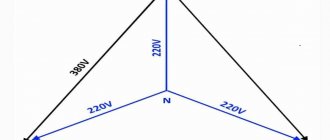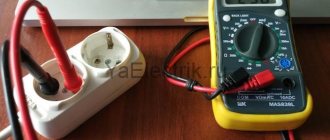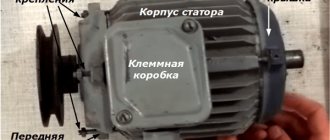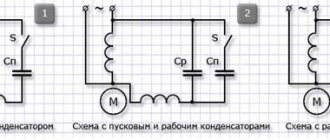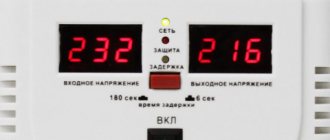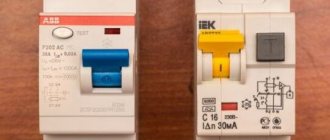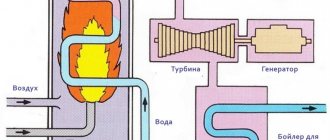Almost all household electrical appliances are designed for a voltage of 220 V. We, without hesitation, plug them into the outlet and enjoy the operation of the devices. But sometimes you need to connect an asynchronous motor designed for 380 V. To start it, you can use a special circuit that allows you to connect the electric motor to a single-phase network, but you will have to put up with a loss of power. Is it possible to turn a single-phase network into a three-phase one and how to make 380 from 220 Volts?
It turns out there is such a possibility. There are several ways to get 380V from a single-phase network. Below we will show how to do this, but first we will understand how a single-phase network differs from a three-phase one.
Theory
At industrial power plants, generators generate three-phase current and increase its voltage to tens and even hundreds of kilovolts. Electricity is supplied to consumers through power lines. But before this, the current enters the power transformer, which lowers the voltage to 380 V. From the distribution substation, the electricity enters the consumer network.
In a three-phase network, the current is supplied in such a way that all three are shifted relative to each other by 120 degrees. The voltage between phases is 380 V, and between phase and neutral 220 V (see Fig. 1). It is this voltage that is supplied to each apartment.
Rice. 1. Three-phase current structure
Since our goal is to obtain 380 V from a single-phase network, we will move on to methods of converting 220 V to 380.
Methods for obtaining 380 Volts from 220
Let's look at the main ways to convert 220 volts into full three-phase current, 380 V:
- using an electronic voltage converter;
- by using a transformer;
- using three phases;
- using a three-phase motor as a generator;
- using a capacitor circuit.
Voltage transformer
The easiest and most reliable way to convert 220 V to 380 is to buy an electronic voltage converter. (see Fig. 2). This device is often called an inverter. The gadget is easy to operate and generates high-quality three-phase current. True, the power of inverters is not very large, but, as a rule, it is enough for most three-phase household appliances.
Rice. 2. Voltage converter
The converter is also good because it has a built-in overload and short circuit protection function. This means that the electric motor will not overheat and will not fail as a result of a short circuit.
High quality current is achieved thanks to the operating principle of the device. The inverter first rectifies single-phase alternating current and then generates three-phase voltage at a given frequency and with a standard phase shift. In this case, the number of phases can be more than 3 (with a corresponding shift angle).
Using a transformer
Using a step-up transformer, you can get any voltage, including 380 V. However, if you are interested in three-phase voltage, then you need a special three-phase transformer. converting single-phase current into three-phase. Such transformers are commercially available.
The transformer windings are connected in star or delta. Single-phase network voltage is supplied to two primary windings directly, and to the third through a capacitor. In this case, the capacitor capacity is selected at the rate of 7 μF for every 100 W of power.
Please note that the rated voltage of the capacitor should not be lower than 400 V. Such a device cannot be turned on without a load.
Although we will obtain the necessary 380 V in this way, there will still be a decrease in the power of the electric motor (if you plan to connect it to a transformer). Accordingly, the engine efficiency will also drop.
Using 3 phases
If you live in an apartment building, then 3 phases are already connected to it, which, in order to optimally distribute the loads, are separated into individual apartments. On each floor there are distribution boards, from where you can bring the missing two phases into the apartment. But this will require permission.
If you wish, you can obtain permission from the energy supply company or coordinate with Energonadzor the installation of three-phase power in your apartment. In this case, you will need to install a three-phase electricity meter.
Using an electric motor
You probably know that the rotor of a conventional three-phase motor, after starting, continues to rotate after one phase is disconnected. It turns out that there is an EMF between the terminal of the disconnected winding and the activated terminals.
The phase shift between the stator windings depends only on their location. In a three-phase motor, these coils are located at an angle of 120º, which means they provide the same phase shift angle. This circumstance suggests that an asynchronous three-phase motor can be used to obtain 380 volts from a conventional single-phase network. A simple diagram for connecting an electric motor is shown in Figure 3. The capacitor in the diagram is needed only to start the engine. Once launched, you can disable it. We take the capacitor type MBGO, MBGP, MBGT or K42-4, the operating voltage of which must be at least 600 V. You can use the capacitor K42-19, with an operating voltage of at least 250 V.
For an example of connecting a phase-shifting capacitor, see Fig. 3.
Rice. 3. Connecting the starting capacitor
We select the parameters of the capacitor depending on the power of the motor. Note that the parameters of the phase-shifting capacitor do not affect the quality of the generated current. We connect the load to the stator windings according to the diagram shown in Fig. 4.
Rice. 4. Three-phase current from an electric motor
The rotor rotation speed is almost independent of the single-phase network voltage, so it can be considered constant. This means that the frequency of three-phase current at rated loads will not change.
It should be borne in mind that the power of a three-phase motor operating from a single-phase network decreases. Accordingly, the rated power of a three-phase load will be approximately one third lower than that stated in the electric motor’s passport.
Electric motor as generator
Another way to get 380 from 220 V is to create a motor-generator system. As a motor, you can take any electric motor operating from a 220 V network, and as a generator, you can take a modified three-phase asynchronous motor (see Fig. 5 for the installation diagram).
Let us immediately note that the effectiveness of such an installation is questionable, but it is possible to obtain the required voltage of 380 V in this way. In this circuit, it is necessary to ensure such a rotor speed that the generator produces current with a frequency of 50 Hz. To do this, it is necessary to rotate the shaft at an angular speed of 1500 rpm.
Rice. 5. Three-phase motor as generator
At home, you can use a single-phase motor from a washing machine or other household appliances as a drive. It is only important to ensure the required angular speed of rotation of the rotor.
Since the rotation of the shaft of electric motors operating, for example, in a washing machine is about 12 - 20 thousand rpm, it is necessary to use pulleys whose diameters have a ratio of 1 to 10. That is, to ensure rotation of the generator rotor at a speed of 1500 rpm min. you can take a pulley that is already mounted on an electric motor from a straightening machine, and put a pulley with a diameter 10 times larger on the shaft of a three-phase motor.
Where to connect the grounding
In addition to neutral and phase, modern electrical wiring uses another conductor - protective grounding. The housings of electrical appliances and lamps are attached to it.
If the insulation between these parts and live elements is broken, a short circuit occurs or a leakage current appears. As a result of this phenomenon, the circuit breaker or differential protection trips, respectively.
In a modern residential power supply system, three grounding schemes are used:
- TN-C. The old grounding system, in which the grounding of power lines is carried out only in the substation, on the neutral of the secondary winding of the transformer, after which a combined PEN conductor is supplied to the consumer, which simultaneously performs the functions of grounding and neutral. In this case, instead of protective grounding, there is a protective grounding and connecting electrical appliance housings to it is prohibited in PUE 1.7.132. To protect people from electric shock in such a system, it is necessary to use an RCD or a circuit breaker.
- TN-CS. This is a more modern system in which in the input panel the combined PEN wire is divided into neutral N and ground PE. The separation point is connected to the building's grounding loop. According to PUE clause 1.7.135, after separation, the connection of these conductors is prohibited. The grounding wire in the apartment electrical wiring in this system must be connected specifically to the PE conductor.
- TN-S. The most modern scheme in which power supply is carried out using five wires - three phase L1, L2 and L3, neutral N and grounding PE. In this case, the grounding is connected only to the grounding conductor.
As a last resort, it is allowed to connect the protective grounding to a separate circuit manufactured in accordance with the PUE standards, paragraphs 1.7.100-118. In this case, a CT grounding system will be obtained.
| Important! It is prohibited to use water, sewer or heating pipes as a grounding conductor. |
Conclusion
In conventional electrical wiring there are only two options for where to get 220 Volts. This is to connect the line to the phase and neutral conductors, except for grounding, or use a step-down transformer. The last method is applicable not only in a 380V network, but also at any other voltage.
conclusions
It is possible to obtain 380 volts from a 220 V network in several ways. The most effective way to use an electronic inverter is:
- stable current parameters;
- safe operation;
- ensuring the declared output power;
- compact installation.
All of the above methods of converting 220 Volts to 380 work, therefore they have the right to exist. But you must be prepared for power loss and difficulties in achieving other current parameters, including its frequency characteristics.
Almost all household electrical appliances are designed for a voltage of 220 V. We, without hesitation, plug them into the outlet and enjoy the operation of the devices. But sometimes you need to connect an asynchronous motor designed for 380 V. To start it, you can use a special circuit that allows you to connect the electric motor to a single-phase network, but you will have to put up with a loss of power. Is it possible to turn a single-phase network into a three-phase one and how to make 380 from 220 Volts?
It turns out there is such a possibility. There are several ways to get 380V from a single-phase network. Below we will show how to do this, but first we will understand how a single-phase network differs from a three-phase one.
Pros and cons of three-phase and single-phase networks
Using a three-phase voltage of 380 V to power a private home has a number of differences from single-phase 220 V, so when deciding to connect to such a network, you should study all the advantages and disadvantages of such a power supply scheme.
A three-phase network has a number of advantages over a single-phase one:
- Smaller cross-section of suitable cable. With an even distribution of the load across phases, it is possible to increase the total power of electrical appliances.
- Connection of three-phase electric motors without additional devices and power loss. Conventional asynchronous electric motors, when connected to a single-phase network, lose a significant part of the torque or it is necessary to purchase a special converter.
- Additional opportunities for modernization and repair of electrical wiring. Knowing how 380 turns into 220, you can change the connection of electrical appliances depending on the specific situation.
In addition, in some cases, supplying three-phase power to the building allows you to obtain permission from the electric company to increase power consumption.
In addition to the advantages, the three-phase power supply circuit also has disadvantages:
- it is necessary to obtain permission to change the circuit from the electric company;
- additional costs for replacing the power cable;
- increased size and cost of equipment in the input panel.
Theory
At industrial power plants, generators generate three-phase current and increase its voltage to tens and even hundreds of kilovolts. Electricity is supplied to consumers through power lines. But before this, the current enters the power transformer, which lowers the voltage to 380 V. From the distribution substation, the electricity enters the consumer network.
In a three-phase network, the current is supplied in such a way that all three are shifted relative to each other by 120 degrees. The voltage between phases is 380 V, and between phase and neutral 220 V (see Fig. 1). It is this voltage that is supplied to each apartment.
Rice. 1. Three-phase current structure
Since our goal is to obtain 380 V from a single-phase network, we will move on to methods of converting 220 V to 380.
Methods for obtaining 380 Volts from 220
Let's look at the main ways to convert 220 volts into full three-phase current, 380 V:
- using an electronic voltage converter;
- by using a transformer;
- using three phases;
- using a three-phase motor as a generator;
- using a capacitor circuit.
Voltage transformer
The easiest and most reliable way to convert 220 V to 380 is to buy an electronic voltage converter. (see Fig. 2). This device is often called an inverter. The gadget is easy to operate and generates high-quality three-phase current. True, the power of inverters is not very large, but, as a rule, it is enough for most three-phase household appliances.
Rice. 2. Voltage converter
The converter is also good because it has a built-in overload and short circuit protection function. This means that the electric motor will not overheat and will not fail as a result of a short circuit.
High quality current is achieved thanks to the operating principle of the device. The inverter first rectifies single-phase alternating current and then generates three-phase voltage at a given frequency and with a standard phase shift. In this case, the number of phases can be more than 3 (with a corresponding shift angle).
Using a transformer
Using a step-up transformer, you can get any voltage, including 380 V. However, if you are interested in three-phase voltage, then you need a special three-phase transformer. converting single-phase current into three-phase. Such transformers are commercially available.
The transformer windings are connected in star or delta. Single-phase network voltage is supplied to two primary windings directly, and to the third through a capacitor. In this case, the capacitor capacity is selected at the rate of 7 μF for every 100 W of power.
Please note that the rated voltage of the capacitor should not be lower than 400 V. Such a device cannot be turned on without a load.
Although we will obtain the necessary 380 V in this way, there will still be a decrease in the power of the electric motor (if you plan to connect it to a transformer). Accordingly, the engine efficiency will also drop.
Using 3 phases
If you live in an apartment building, then 3 phases are already connected to it, which, in order to optimally distribute the loads, are separated into individual apartments. On each floor there are distribution boards, from where you can bring the missing two phases into the apartment. But this will require permission.
If you wish, you can obtain permission from the energy supply company or coordinate with Energonadzor the installation of three-phase power in your apartment. In this case, you will need to install a three-phase electricity meter.
Using an electric motor
You probably know that the rotor of a conventional three-phase motor, after starting, continues to rotate after one phase is disconnected. It turns out that there is an EMF between the terminal of the disconnected winding and the activated terminals.
The phase shift between the stator windings depends only on their location. In a three-phase motor, these coils are located at an angle of 120º, which means they provide the same phase shift angle. This circumstance suggests that an asynchronous three-phase motor can be used to obtain 380 volts from a conventional single-phase network. A simple diagram for connecting an electric motor is shown in Figure 3. The capacitor in the diagram is needed only to start the engine. Once launched, you can disable it. We take the capacitor type MBGO, MBGP, MBGT or K42-4, the operating voltage of which must be at least 600 V. You can use the capacitor K42-19, with an operating voltage of at least 250 V.
For an example of connecting a phase-shifting capacitor, see Fig. 3.
Rice. 3. Connecting the starting capacitor
We select the parameters of the capacitor depending on the power of the motor. Note that the parameters of the phase-shifting capacitor do not affect the quality of the generated current. We connect the load to the stator windings according to the diagram shown in Fig. 4.
Rice. 4. Three-phase current from an electric motor
The rotor rotation speed is almost independent of the single-phase network voltage, so it can be considered constant. This means that the frequency of three-phase current at rated loads will not change.
It should be borne in mind that the power of a three-phase motor operating from a single-phase network decreases. Accordingly, the rated power of a three-phase load will be approximately one third lower than that stated in the electric motor’s passport.
Electric motor as generator
Another way to get 380 from 220 V is to create a motor-generator system. As a motor, you can take any electric motor operating from a 220 V network, and as a generator, you can take a modified three-phase asynchronous motor (see Fig. 5 for the installation diagram).
Let us immediately note that the effectiveness of such an installation is questionable, but it is possible to obtain the required voltage of 380 V in this way. In this circuit, it is necessary to ensure such a rotor speed that the generator produces current with a frequency of 50 Hz. To do this, it is necessary to rotate the shaft at an angular speed of 1500 rpm.
Rice. 5. Three-phase motor as generator
At home, you can use a single-phase motor from a washing machine or other household appliances as a drive. It is only important to ensure the required angular speed of rotation of the rotor.
Since the rotation of the shaft of electric motors operating, for example, in a washing machine is about 12 - 20 thousand rpm, it is necessary to use pulleys whose diameters have a ratio of 1 to 10. That is, to ensure rotation of the generator rotor at a speed of 1500 rpm min. you can take a pulley that is already mounted on an electric motor from a straightening machine, and put a pulley with a diameter 10 times larger on the shaft of a three-phase motor.
Converting an asynchronous motor into a generator
Remove the covers and remove the rotor.
The stator windings remain original, the motor is not rewound, everything remains as is, without changes. The rotor was modified to order. It was decided to make it not all-metal, but prefabricated. That is, the original rotor is ground down to a certain size. A steel cup is turned out and pressed onto the rotor. The scan thickness in my case is 5 mm. Marking the places for gluing the magnets was one of the most difficult operations. As a result, through trial and error, it was decided to print the template on paper, cut out circles in it for neodymium magnets - they are round. And glue the magnets according to the template onto the rotor. The main snag arose in cutting out multiple circles in the paper. All sizes are selected individually for each engine. It is impossible to give any general dimensions for the placement of magnets. Neodymium magnets are glued with super glue. A mesh of nylon thread was made for strengthening. Next, everything is wrapped with tape, a sealed formwork is made from below, sealed with plasticine, and a filling funnel is made from the same tape on top. Everything is filled with epoxy resin. The resin slowly flows down from top to bottom. After the epoxy resin has hardened, remove the tape. Now everything is ready to assemble the generator. We drive the rotor into the stator. This must be done with extreme caution, since neodymium magnets have enormous strength and the rotor literally flies into the stator. Assemble and close the lids. The magnets don't touch. There is almost no sticking, it turns relatively easily. Checking the work. We rotate the generator from a drill, with a rotation speed of 1300 rpm. The engine is connected in a star; generators of this type cannot be connected in a triangle; they will not work. The voltage is removed to check between phases. The generator from an asynchronous motor works perfectly. For more detailed information, see the video. Author's channel - The answer to the question of how to make your own electric generator from an electric motor is based on knowledge of the structure of these mechanisms. The main task is to convert the engine into a machine that functions as a generator. In this case, you should think about how this entire assembly will be set in motion.
conclusions
It is possible to obtain 380 volts from a 220 V network in several ways. The most effective way to use an electronic inverter is:
- stable current parameters;
- safe operation;
- ensuring the declared output power;
- compact installation.
All of the above methods of converting 220 Volts to 380 work, therefore they have the right to exist. But you must be prepared for power loss and difficulties in achieving other current parameters, including its frequency characteristics.
There are situations in life when you need to start a 3-phase asynchronous electric motor from a household network. The problem is that you only have one phase and a “zero” at your disposal.
What to do in such a situation? Is it possible to connect a three-phase motor to a single-phase network?
If you approach your work wisely, everything is possible. The main thing is to know the basic schemes and their features.
CONTENTS (click on the button on the right):
Design features
Before starting work, understand the design of the IM (induction motor).
The device consists of two elements - a rotor (moving part) and a stator (fixed unit).
The stator has special grooves (recesses) into which the winding is placed, distributed in such a way that the angular distance is 120 degrees.
The windings of the device create one or more pairs of poles, the number of which determines the frequency with which the rotor can rotate, as well as other parameters of the electric motor - efficiency, power and other parameters.
When an asynchronous motor is connected to a three-phase network, current flows through the windings at different time intervals.
A magnetic field is created that interacts with the rotor winding and causes it to rotate.
In other words, a force appears that turns the rotor at different time intervals.
If you connect the IM to a network with one phase (without performing preparatory work), the current will appear in only one winding.
The torque generated will not be enough to move the rotor and keep it spinning.
That is why, in most cases, the use of starting and operating capacitors is required to ensure the operation of a three-phase motor. But there are other options.
Types and description of asynchronous motor
There are two types of motors:
- Squirrel-cage rotor
. It includes a stator (non-moving element) and a rotor (rotating element), which moves due to the operation of bearings attached to two motor shields. The cores are made of steel, and they are also insulated from each other. An insulated wire is located along the grooves of the stator core, and a rod winding is installed along the grooves of the rotor core or molten aluminum is poured. Special jumper rings play the role of a closing element of the rotor winding. Independent developments transform the mechanical movements of the motor and create alternating voltage electricity. Their advantage is that they do not have an alkaline collector mechanism, which makes them more reliable and durable. - A wound rotor
is an expensive device that requires specialized service. The composition is the same as that of the short circuit rotor. The only exception is that the rotor and stator windings of the core are made of insulated wire, and its ends are connected to rings attached to the shaft. Special brushes pass through them, which connect the wires with an adjusting or starting rheostat. Due to the low level of reliability, it is used only for those industries for which it is intended.
How to connect an electric motor from 380 to 220V without a capacitor?
As noted above, to start an electric motor with a squirrel-cage rotor from a single-phase network, a capacitor is most often used.
It is this that ensures the device starts at the first moment after the single-phase current is supplied. In this case, the capacity of the starting device should be three times higher than the same parameter for the working capacity.
For motors with a power of up to 3 kilowatts and used at home, the price of starting capacitors is high and sometimes comparable to the cost of the motor itself.
Consequently, many are increasingly avoiding containers used only at the moment of start-up.
The situation is different with working capacitors, the use of which allows you to load the motor at 80-85 percent of its power. If they are absent, the power indicator may drop to 50 percent.
However, capacitorless starting of a 3-phase motor from a single-phase network is possible thanks to the use of bidirectional switches that operate for short periods of time.
The required torque is provided by the displacement of phase currents in the windings of the IM.
Today, two schemes are popular, suitable for motors with power up to 2.2 kW.
It is interesting that the start-up time of the IM from a single-phase network is not much lower than in the usual mode.
The main elements of the circuit are triacs and symmetrical dinistors. The first are controlled by multi-polar pulses, and the second by signals coming from the half-cycle of the supply voltage.
Suitable for 380 Volt electric motors up to 1,500 rpm with delta windings.
The RC circuit acts as a phase-shifting device. By changing the resistance R2, it is possible to achieve a voltage across the capacitor that is shifted by a certain angle (relative to the household network voltage).
The main task is performed by the symmetrical dinistor VS2, which at a certain point in time connects a charged capacitance to the triac and activates this switch.
Suitable for electric motors with a rotation speed of up to 3000 rpm and for motors with increased resistance at start-up.
Such motors require more starting current, so an open star circuit is more relevant.
A special feature is the use of two electronic switches that replace phase-shifting capacitors. During the adjustment process, it is important to ensure the required shift angle in the phase windings.
This is done as follows:
- Voltage is supplied to the electric motor through a manual starter (it must be connected in advance).
- After pressing the button, you need to select the starting moment using resistor R
When implementing the considered schemes, it is worth considering a number of features:
- For the experiment, radiatorless triacs (types TS-2-25 and TS-2-10) were used, which showed excellent results. If you use triacs on a plastic case (imported), you cannot do without radiators.
- A symmetrical DB3 type dinistor can be replaced with a KP. Despite the fact that the KP1125 is made in Russia, it is reliable and has a lower switching voltage. The main drawback is the scarcity of this dinistor.
Step by step guide
- Since you will need to reconfigure the generator so that the rotation speed exceeds the engine speed, you must first connect the engine to the mains and start it. Then use a tachometer to determine the speed of its rotation.
- Having found out the speed, you should add another 10% to the resulting designation.
For example, the technical indicator of the motor is 1000 rpm, then the generator should have about 1100 rpm (1000*0.1%=100, 1000+100=1100 rpm). - You should select a capacitance for the capacitors.
To determine the sizes, use the table data.
How to connect via capacitors
First, decide which circuit is assembled on the ED. To do this, open the bar cover where the blood pressure terminals are output, and see how many wires come out of the device (most often there are six).
The designations are as follows: C1-C3 are the beginnings of the winding, and C4-C6 are its ends. If the beginnings or ends of the windings are combined with each other, this is a “star”.
The most difficult situation is if six wires simply come out of the housing. In this case, you need to look for the corresponding designations on them (C1-C6).
To implement a scheme for connecting a three-phase electric motor to a single-phase network, two types of capacitors are required - starting and working.
The first ones are used to start the electric motor at the first moment. As soon as the rotor spins to the required number of revolutions, the starting capacitance is excluded from the circuit.
If this does not happen, there may be serious consequences, including engine damage.
The main function is performed by working capacitors. Here it is worth considering the following points:
- Working capacitors are connected in parallel;
- The rated voltage must be at least 300 Volts;
- The capacity of the working capacitors is selected taking into account 7 µF per 100 W;
- It is desirable that the type of working and starting capacitor be identical. Popular options are MBGP, MPGO, KBP and others.
If you take these rules into account, you can extend the life of the capacitors and the electric motor as a whole.
Capacity calculations must be made taking into account the rated power of the electric motor. If the motor is underloaded, overheating is inevitable, and then the capacity of the working capacitor will have to be reduced.
If you choose a capacitor with a capacitance less than acceptable, the efficiency of the electric motor will be low.
Remember that even after the circuit is turned off, the voltage remains on the capacitors, so it is worth discharging the device before starting work.
Also note that connecting an electric motor with a power of 3 kW or more to conventional wiring is prohibited, as this can lead to the machines turning off or the plugs burning out. In addition, there is a high risk of insulation melting.
To connect ED 380 to 220V using capacitors, proceed as follows:
- Connect the containers to each other (as mentioned above, the connection should be parallel).
- Connect the parts with two wires to the electric motor and a single-phase alternating voltage source.
- Turn on the engine. This is done in order to check the direction of rotation of the device. If the rotor moves in the desired direction, no additional manipulations are needed. Otherwise, the wires connected to the winding should be swapped.
With a capacitor, an additional simplified one is for a star circuit.
With a capacitor, an additional simplified one is for a triangle circuit.
Principle of operation
The generator produces electrical energy provided that the number of rotor revolutions is slightly higher than the synchronous speed. The simplest type produces about 1800 rpm, taking into account that its synchronous speed level becomes 1500 rpm.
Its operating principle is based on the conversion of mechanical energy into electricity. You can force the rotor to rotate and produce electricity using a strong torque. Ideally, a constant idle speed that can maintain the same speed.
All types of motors operating on intermittent current are called asynchronous.
In them, the magnetic field of the stator spins faster than the field of the rotor, accordingly directing it in the direction of its movement. To change the electric motor into a functioning generator, you will need to increase the speed of the rotor so that it does not follow the magnetic field of the stator, but begins to move in the other direction.
You can get a similar result by connecting the device to the mains, with a large capacitance or a whole group of capacitors. They charge and accumulate energy from magnetic fields. The capacitor phase has a charge that is opposite to the motor current source, which causes the rotor to slow down and the stator winding to generate current.
How to connect with reverse
There are situations in life when you need to change the direction of rotation of the motor. This is also possible for three-phase electric motors used in a household network with one phase and zero.
To solve the problem, it is necessary to connect one terminal of the capacitor to a separate winding without the possibility of breaking, and the second - with the possibility of transferring from the “zero” to the “phase” winding.
To implement the circuit, you can use a switch with two positions.
The wires from “zero” and “phase” are soldered to the outer terminals, and the wire from the capacitor is soldered to the central terminal.
Generator circuit
The scheme is very simple and does not require special knowledge and skills. If you start the development without connecting it to the network, rotation will begin and, after reaching a synchronous frequency, the stator winding will begin to generate electrical energy.
By attaching a special battery of several capacitors (C) to its terminals, you can obtain a leading capacitive current, which will create magnetization. The capacitance of the capacitors must be higher than the critical designation C 0, which depends on the dimensions and characteristics of the generator.
In this situation, a self-starting process occurs, and a system with symmetrical three-phase voltage is mounted on the stator winding. The current generated directly depends on the capacitance of the capacitors, as well as the characteristics of the machine.
How to connect in a star-delta connection (with three wires)
For the most part, domestically produced EDs already have a star circuit assembled. All that is required is to reassemble the triangle.
The main advantage of the star/delta connection is the fact that the engine produces maximum power.
Despite this, such a scheme is rarely used in production due to the complexity of implementation.
To connect the motor and make the circuit operational, three starters are required.
The current is connected to the first (K1), and the stator winding is connected to the other. The remaining ends are connected to starters K3 and K2.
Next, the winding of the last starter (K2) is combined with the remaining phases to create a delta circuit.
When the K3 starter is connected to the phase, the remaining ends are shortened and the circuit is converted into a “star”.
Please note that simultaneous activation of K2 and K3 is prohibited due to the risk of a short circuit or knocking out of the AV supplying the ED.
To avoid problems, a special interlock is provided, which means turning off one starter when turning on the other.
The operating principle of the circuit is simple:
- When the first starter is connected to the network, the time relay starts and supplies voltage to the third starter.
- The engine starts working in a star configuration and starts working with more power.
- After some time, the relay opens contacts K3 and connects K2. In this case, the electric motor operates in a “triangle” pattern with reduced power. When it is necessary to turn off the power, K1 turns on.
Where is the generator used?
Equipment of this type is used in completely different areas. This can be an industrial facility, private or suburban housing, a construction site of any scale, or civil buildings for various purposes.
In a word, a set of components such as an electric generator of any type and an electric motor allows you to implement the following tasks:
- Backup power supply;
- Autonomous power supply on a constant basis.
In the first case, we are talking about an insurance option in case of dangerous situations such as network overload, accidents, outages, etc. In the second case, a different type of electric generator and an electric motor make it possible to obtain electricity in areas where there is no centralized network. Along with these factors, there is another reason why it is recommended to use an autonomous power source - this is the need to supply a stable voltage to the consumer input. Such measures are often taken when it is necessary to put into operation equipment with particularly sensitive automation.

